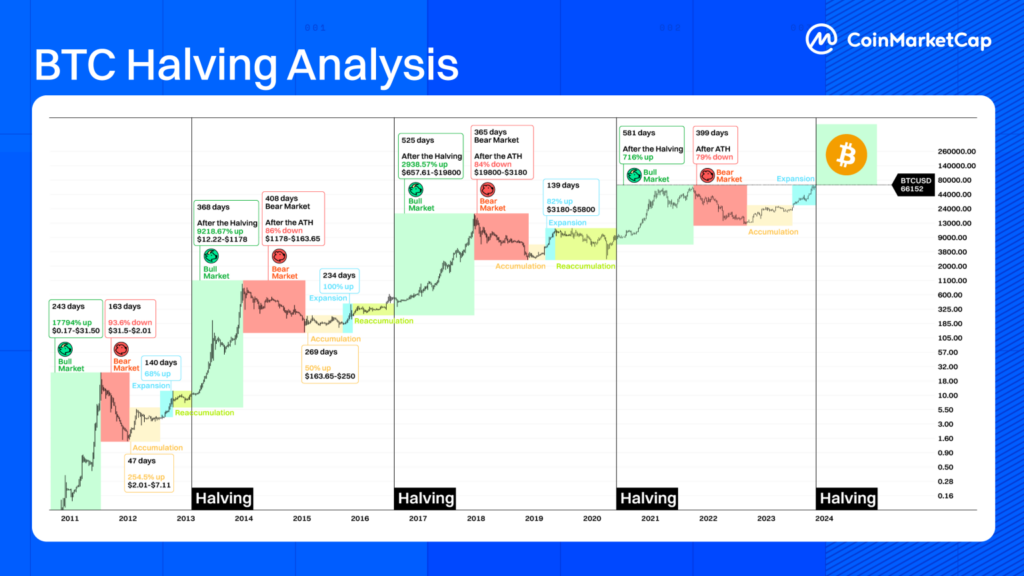Bitcoin’s halving event is a fundamental aspect of the Bitcoin protocol, designed to control the supply of the cryptocurrency and ensure its scarcity over time. By halving the block reward every 210,000 blocks, or roughly every four years, Bitcoin’s issuance rate slows, ultimately capping the total supply at 21 million coins. This mechanism has profound effects on the market, often triggering significant price movements and influencing the broader crypto ecosystem. In this article, we will explore the history of Bitcoin halving, its market impact, and what to expect from future halvings.

What is Bitcoin’s halving event?
Bitcoin halving is an event programmed into the Bitcoin protocol by its creator, Satoshi Nakamoto. It occurs after every 210,000 blocks are mined, roughly every four years. The block reward, which is the incentive given to miners for validating transactions and adding them to the blockchain, is reduced by 50%. This mechanism ensures that the supply of new Bitcoin decreases over time, contributing to its scarcity and value proposition.

Historical Impact of Bitcoin’s Halving Events
- First Halving (2012): The first Bitcoin halving occurred on November 28, 2012, reducing the block reward from 50 to 25 Bitcoins. Before the halving, Bitcoin’s price hovered around $12. After the event, the price surged, reaching approximately $1,000 by late 2013.
- Second Halving (2016): The second halving took place on July 9, 2016, cutting the reward from 25 to 12.5 Bitcoins. Leading up to the halving, Bitcoin’s price steadily increased, from about $650 in mid-2016 to nearly $20,000 by December 2017. This period saw a significant influx of retail investors and the beginning of widespread mainstream attention.
- Third Halving (2020): On May 11, 2020, the reward was reduced from 12.5 to 6.25 Bitcoins. In the months preceding this halving, Bitcoin’s price saw substantial volatility, exacerbated by the global COVID-19 pandemic. However, post-halving, Bitcoin entered a bull market, reaching an all-time high of over $64,000 in April 2021. The bull run was driven by increased institutional investment and the perception of Bitcoin as a hedge against inflation.

Factors Influencing Price After Bitcoin’s Halving Event
- Supply and Demand Dynamics: Halving events reduce the rate at which new Bitcoins are introduced into the market. With a fixed supply cap of 21 million Bitcoins, reduced issuance puts upward pressure on prices if demand remains constant or increases. The economic principle of scarcity plays a significant role here.
- Market Sentiment and Speculation: Halvings generate substantial media attention and speculation. Positive sentiment can drive prices up as investors anticipate future gains. Conversely, uncertainty and fear of potential market corrections can lead to volatility.
- Mining Economics: The reduction in mining rewards impacts miners’ profitability. Higher prices post-halving can offset the reduced rewards, encouraging miners to continue operations. If prices do not rise sufficiently, less efficient miners may be forced to shut down, reducing the overall hash rate and potentially impacting network security.
- Institutional Involvement: Increasing institutional adoption of Bitcoin, such as investments by companies like Tesla and the availability of Bitcoin ETFs, can drive demand and influence price movements post-halving.

Implications for Miners
Miners are directly affected by halving events. The reduced block reward impacts their revenue, necessitating adjustments in operations to maintain profitability. Here are some key considerations for miners:
- Operational Efficiency: Miners need to invest in more efficient hardware and optimize their operations to lower energy costs. The transition to newer, more efficient mining equipment can help maintain profitability despite reduced rewards.
- Electricity Costs: Electricity is one of the most significant expenses for miners. Securing low-cost energy sources becomes even more crucial post-halving. Some miners may relocate to regions with cheaper electricity or invest in renewable energy sources.
- Mining Pool Participation: To mitigate the impact of reduced rewards, miners often join mining pools, where they combine their computational power to increase the chances of successfully mining blocks. This can provide more consistent payouts, albeit shared among pool participants.
- Market Strategy: Miners need to be mindful of market conditions and potential price movements. Some may choose to hold (HODL) their mined Bitcoins in anticipation of price increases, while others might sell immediately to cover operational costs.
Implications for Investors
For investors, understanding the dynamics of Bitcoin’s halving events can inform investment strategies:
- Long-Term Investment: Historical data suggests that Bitcoin’s price tends to rise significantly in the months and years following a halving. Long-term investors may view halvings as an opportunity to buy and hold Bitcoin, expecting future appreciation.
- Diversification: Investors might consider diversifying their crypto portfolio to manage risk. While Bitcoin remains the dominant cryptocurrency, other assets may offer different risk-reward profiles.
- Market Timing: Timing the market around halving events can be challenging due to volatility and speculation. Investors should be cautious and avoid making decisions based solely on halving expectations.
- Regulatory Environment: Investors need to stay informed about regulatory developments that could impact the cryptocurrency market. Regulation changes can influence market sentiment and price movements.

Future Halving Events
The next Bitcoin halving is expected to occur around 2024, reducing the block reward to 3.125 Bitcoins. As the total supply of Bitcoin approaches its 21 million cap, halvings will continue to shape the cryptocurrency’s economic landscape.
Future halvings will occur approximately every four years until the last Bitcoin is mined around 2140. As block rewards diminish, transaction fees are expected to become a more significant source of income for miners. This transition will be critical for maintaining network security and incentivizing miners.
Visits: 9679
